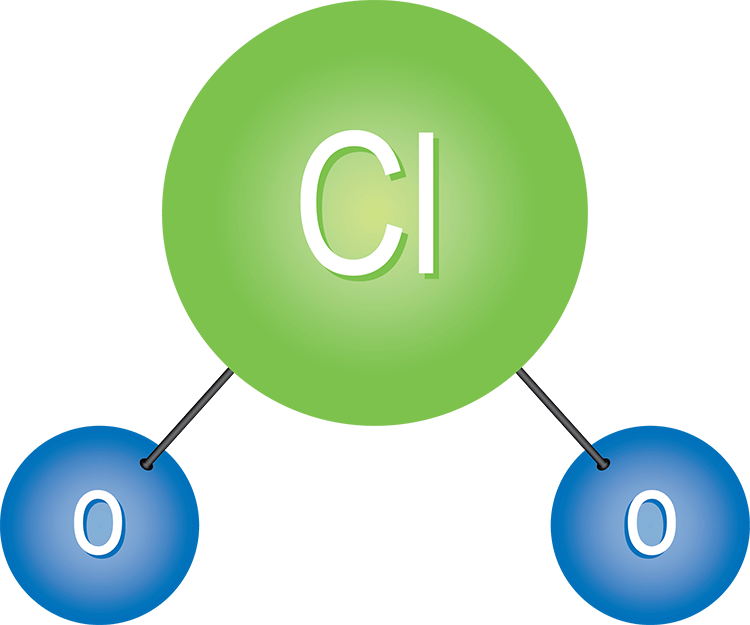The Science
The science behind how Chlorine Dioxide is so effective against bacteria and microorganisms is complex, but here goes a simplified version… SCD(stabilised chlorine dioxide) has selective reactivity and penetrates the cell membranes of bacteria. This reaction disrupts the functions of the bacterial cells proteins and enzymes, destroying the cell wall causing the cell to die.
Chlorine dioxide is also among the only disinfectant that have proven to be effective when used to eliminate Cryptosporidium and Giardia Lamblia parasites.
It is effective across a large range of pH.
It does not oxidize organic compounds, therefore unlike chlorine, it does not form chlorinated organic compounds as by-products (some of which can be carcinogenic). It only reacts when it encounters atoms willing to donate electrons (i.e. to undergo oxidation), which are common in proteins that are part of exogenous microorganisms.
Chlorine dioxide when dosed properly, instantaneously reacts with soluble iron and manganese to form insoluble iron and manganese precipitates that fall out of suspension and are easily removed by filtration.

Comparison to Hydrogen Peroxide
Silver Stabilised Hydrogen Peroxide is a water treatment solution used to disinfect water. It is a combination of hydrogen peroxide and silver ions. The silver ions stabilise the hydrogen peroxide and enhance its effectiveness as a disinfectant.
While it is used to disinfect water, it is not as effective at killing microorganisms as Chlorine Dioxide. Silver Stabilised Hydrogen Peroxide is also ineffective at removing odours or tastes from water.
In comparison to hydrogen peroxide, SCD(stabilised chlorine dioxide) is highly effective at low concentrations. Meaning it can be used in smaller quantities, making it more cost-effective. This also means less risk of producing by-products.
SCD(stabilised chlorine dioxide) has a beneficial residual effect, meaning it remains active for longer in comparison to other treatments, ensuring water remains safer for extended periods.
If we compare the make up of hydrogen peroxide and SCD(stabilised chlorine dioxide), it is relatively unstable, especially when exposed to light and heat, causing it to break down quicker, leading to less residual effects, allowing for regrowth of bacteria.
Some of our more recent poultry customers have been using hydrogen peroxide to disinfect and clean their lines for around 5 years. Unfortunately, due to the corrosive nature of hydrogen peroxide (at higher concentrations), they have been experiencing corrosion throughout their sheds and drinkers. Using SCD helps mitigate this problem.
Comparison to Chlorine
Yes, we know stabilised chlorine dioxide has chlorine in its name, however SCD(stabilised chlorine dioxide) far exceeds the uses of chlorine.
Chlorine Dioxide is a top choice for water disinfection due to its superior effectiveness, safety, and versatility. Chlorine Dioxide boasts 2.5 times the oxidizing power of Chlorine, allowing it to neutralize a wider range of pathogens, including bacteria, viruses, and protozoa—at lower concentrations. Its high solubility ensures even distribution, disinfecting without producing harmful by-products.
Chlorine has some drawbacks, it can react with naturally occurring organic matter in water to form harmful by-products such as Trihalomethanes and haloacetic acids, known to cause cancer and other health problems. Chlorine can leave an unpleasant odour and taste which nobody likes in their water!
Don’t just take our word for it! Here are some links to scientific articles;
- A systematic review on chlorine dioxide as a disinfectant - PMC (nih.gov)
- Iron and Manganese control - Chlorine Dioxide Oxidizes Iron & Manganese | International Dioxide (idiclo2.com)
- Antimicrobial efficiency of chlorine dioxide and its potential use as anti-SARS-CoV-2 agent: mechanisms of action and interactions with gut microbiota | Journal of Applied Microbiology | Oxford Academic (oup.com)
- Pathogens | Free Full-Text | Effectiveness of Disinfection with Chlorine Dioxide on Respiratory Transmitted, Enteric, and Bloodborne Viruses: A Narrative Synthesis (mdpi.com)
- The effect of Southwell Ltd chlorine dioxide on Pseudomonas syringae pv actinidiae (PSA) biofilms
